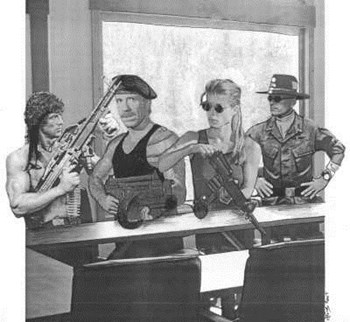
Every board is different, with its own individual personalities meshing for one common cause: to run the co-op or condo in their charge efficiently and with integrity.
Some board members come to their positions with years of experience. Others are neophytes. Some board members are reticent, thoughtful and measured in their approaches. Others are more vociferous, taking charge and moving things forward quickly and aggressively. These are all legitimate approaches to running a building, and any one of them can work well for the benefit of the community.
There are times, however, when one board member's personality or approach to the job can throw a wrench into the whole system. They're the people who try to dominate a meeting, try to push their agendas no matter what the cost, and try to bully their fellow board members into seeing things their way. They're the folks that boards and management dread.
(Mostly) Good Apples
Before things get too gloomy however, it's important to remember that the vast majority of board members approach their duties with a sense of integrity and a desire to do what is best for the fellow residents they were elected to serve. It's actually rare to see a board member really allow their self-interest get the better of them, and create difficult situations for everyone else around them. Perhaps they don't even realize they're doing it. Whatever the reason, the result is the same: both the residents and the building suffer.
There are ways to solve these problems though, and the answer is not always to simply vote these troublesome board members off the proverbial island. Finding that solution starts with finding the root of the problem and understanding that there are a number of reasons why a board member might cause trouble—whether that trouble takes the form of inappropriate aggression, passive-aggressive foot-dragging or simple ignorance.
"People who serve on boards are not always qualified," says Mona Shyman, vice president of the Federation of New York Housing Cooperatives and Condominiums (FNYHC) and veteran board member herself. "[A lot of] board members simply do not have the experience to run a multi-million dollar business," Shyman says, adding that in larger buildings, that's exactly what a co-op or condo is.
That lack of practical experience and knowledge can cause disruption on the board as people lobby back and forth on different issues. One person might think they know better than another, but if there is no basis in fact for that belief, troubles can arise.
It's equally disruptive when a board member starts to focus on his or her personal agenda versus the board's official agenda. If, for example, one board member wants to purchase another unit in the building, he may continually push that into discussion, hoping his position on the board will help him get it resolved more quickly.
That approach not only creates a backlog of other issues, but also foments resentment among other board members and residents. "A board member should never receive special treatment," says Sam Irlander of Manhattan-based management firm Parker Madison Partners Inc., and education chairman for the Real Estate Board of New York (REBNY).
"Board members who solely focus on issues of their interest and not the fiduciary responsibilities they were elected to fulfill" can be very disruptive, continues Irlander. "They should never put their own personal needs against the needs of the many. That's not to say that there may not be legitimate issues that they bring up, but maybe those issues aren't going through proper channels. That's not right. It's not what the post requires."
Boards should keep an eye out, too, for warning signs such as excessive one-on-one conversations between board members or committee members and employees, which could indicate that the board member is perhaps trying to get things done outside the parameters of procedure. According to Margie Russell, the executive director of the New York Association of Realty Managers (NYARM), a readiness to put aside the rules during meetings is also a sign of problems that need to be addressed sooner rather than later. "If the meeting rules are put aside, then there are no boundaries," she says. "Even if it seems harmless, it's a slippery slope."
What's the Harm?
So say your board has a bully in its midst, or someone who continually drives meetings off the tracks, or who clings to their own agenda regardless of the task at hand. What's the big deal? Is it really worth jeopardizing board harmony to avoid ruffling the problem person's feathers?
In a word, says Irlander, the answer is no. "It becomes difficult to move forward and transact business," he says. "No one wants to rub anybody the wrong way, so you start running into setbacks and your meetings don't progress."
"[A troublemaker] on the board can take a great toll," says Russell. "The good board members could shrink to the side and not voice their opinions in the face of these other issues. They may not speak up if they keep getting drowned out."
Building staff members can suffer at the hands of a loose-cannon board member as well. "Staff always get stuck in the middle in these situations," Russell says. "If one board member becomes buddy-buddy with a staff member, it puts that staff member in an awkward position."
It can also create problems between staff and other board members, especially if a staff member begins to flaunt his or her relationship with the person in authority. It can also send the message that perhaps employees can control certain things within the building if they cultivate those relationships. Basically, it disrupts the chain of command, leading to bigger and potentially more serious problems down the road.
Finding a Solution
There are a number of ways to rein in an out-of-control board member, but it's not always easy. "It's very difficult to get rid of people who are strong and trying to rule the world," says Shyman.
One approach calls for the board president to regain and then ensure strict, by-the-book conduct of all meetings. "One way to battle or contain these problems is to run your board meetings very precisely," Russell says. "Follow Robert's Rules of Order, staying with the heart of compliance and procedure."
It's in the absence of structure that those demanding voices try to fill the vacuum, continues Russell. "Robert's Rules were created for a reason. They allow the weaker members of a group to have a voice along with every other member." And that's important in an organization that relies upon the intellectual contribution of each and every person on its board.
Irlander suggests having a serious discussion with the "problem person" in question. "Have the powers that be have direct discussions with people," he says. Meeting one-on-one outside of the meeting means that little or no time will be directly taken up with the issue during actual board meetings. These face-to-face talks have the added benefit of being less threatening to the troublemaker, and allows them to save face.
Irlander also underscores the idea that board members—not managers—should solve board problems. "If a problem persists, it's up to the board to decide how to take care of it, not the manager," he says.
For someone intent on championing their own agenda at the expense of the bigger picture, this also might be a good time to remind him or her about their fiduciary and administrative duties as a volunteer board member. "Fiduciary duty equals the highest position of trust," Irlander says. "It means putting the interest of those you're representing above all else. You have a responsibility to transact business for others. Your needs become secondary."
Irlander also agrees with Russell in terms of following procedure. Part of reminding the individual in question of their fiduciary responsibility should also be a reminder of the proper procedures for getting their interests or questions before the rest of the board. "There's an agenda that corporate policy requires," Irlander says. Before any matters can be discussed, they must be put on the agenda and they must be put there after running through the proper channels.
Shyman suggests a solution that can help prevent personality clashes and disruptions before they begin: the creation of a nominating committee to help handpick board members. "That way you can weed out the people who aren't qualified," she says, and recruit those who are most qualified.
Finding those quality candidates is often a difficult task. "In a large building, very few people know each other, and they really don't know each other's ways," Shyman says, so it's difficult to assess how good a board member they might be. A nominating committee conducts interviews and gets to know the candidates for open board positions.
A nominating committee can also help prevent stagnation, another problem that can lead to tensions and disruptive board members. "You've got 290 apartments and nine people on the board and every year, we elect three people," Shyman says. "Who runs? The incumbents. It helps to mix things up."
Recognizing and preventing issues with board members early on is key because it can be extraordinarily difficult to remove a board member who is causing more problems than they're solving.
"It's your neighbor, so you yourself aren't going to do anything," Shyman says. And when it comes to board officers, the only way to get rid of them is for someone to go to the shareholders and begin impeachment proceedings. And with that, a two-thirds vote is generally needed to make it happen—which is to say, it doesn't happen very often.
So when tensions flare and bring out the worst in a fellow board member, it's important to remember that it's not the end of the world. The rest of the board has to stand its ground and remember its purpose: to run the building fairly and effectively. And while working with the occasional difficult board member is perhaps inevitable, such individuals need to be handled in a way that preserves the integrity and well-being of the home each and every resident and board member shares.
Liz Lent is a teacher and freelance writer living in Bloomfield Hills, Michigan.









24 Comments
Leave a Comment